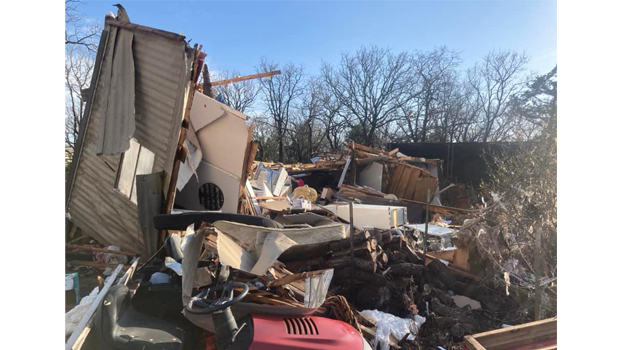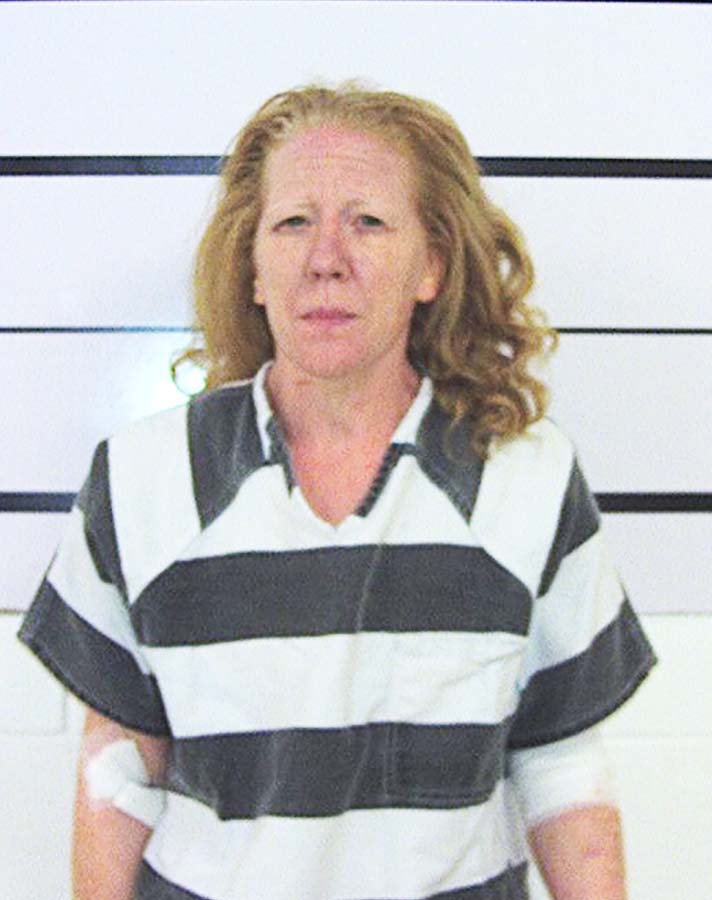NEWS
March record month for tornadoes across the southern states

By Adriana Navarro,
AccuWeather staff writer
The month of March across the contiguous United States ended as it began: stormy. As the seasons clashed and spring fought to overtake winter, the tumultuous pattern sparked numerous severe weather events across the nation. When the final tally is in, March 2022 very well could set a record for the most tornadoes ever in the month of March across the U.S. since record-keeping began.
AccuWeather forecasters say global warming could be one factor behind the exceptional number of tornadoes in March.
Montague County was the site of three separate EF-1 tornadoes on March 21 which caused major damage across the area.
At least 253 preliminary tornado reports were recorded throughout March 2022, according to the latest count from the Storm Prediction Center. While the number is preliminary, only 193 of the reports need to be confirmed as actual tornadoes to break the record of 192 confirmed tornadoes in 2017, according to the National Climatic Data Center. Records date back to 1950, though the numbers for 2020 through 2022 are preliminary.
The devastating storms that charged through the Midwest on the weekend of March 5, claiming the lives of at least seven people, served as a precursor to what the rest of the month would look like. It was during this storm that an EF4 tornado spawned, tearing through Winterset, Iowa, and killing six people, including four members of one family. This was also the storm during which the National Weather Service experienced a dissemination delay with their products, impacting the delivery time of tornado warnings.
While an NWS spokesperson said the service was still able to get the warnings out ahead of each tornado and had communicated the warning roughly 20 minutes before the tornado tore through Winterset, the technical difficulty was noted by U.S. lawmakers who days later introduced the TORNADO act.
Severe weather continued to spawn tornadoes, damaging wind gusts and hail throughout the month as the jet stream dipped into the south-central U.S., pulling moisture from the Gulf Coast northward, according to AccuWeather Chief Broadcast Meteorologist Bernie Rayno.
Cold intrusions from the north and desert air coming in from the west over the South Central states met abundant Gulf moisture, sparking the severe weather that residents in the area witnessed during March.
While many of the storms spawned a tornado or two throughout the month, the next outbreak sizeable in comparison to that at the beginning of the month didn’t come until March 21 to March 22 when severe weather charged through Texas and continued eastward.
This round of severe weather may bring to mind the video of a red truck tossed about in a tornado, accounts of two heavily damaged schools with no fatalities and the image of a huge tornado looming over New Orleans.
The storm claimed at least five lives, including that of a 73-year-old woman in the Grayson County community of Sherwood Shores in North Texas, a 25-year-old man in the New Orleans suburb of Arabi and three motorists in Holt, Alabama, who were found in their car, submerged in floodwaters.
For most of March, the contiguous U.S. didn’t go more than three days without a report of a tornado touching down, according to the Storm Prediction Center. Then, following March 23, there were five relatively calm days — the longest the month had gone without having a tornado report.
As the old adage in the weather business goes, though, the storm was not far behind.
A second round of severe weather soon struck not just the South but also the Midwest and Northeast the following week from March 29 to March 31, with at least 55 tornadoes confirmed across 13 states.
Unusually warm water in the Gulf of Mexico may have had a role in these previous two outbreaks, according to AccuWeather Chief Meteorologist Jonathan Porter.
“AccuWeather meteorologists noted unusually warm water off the Louisiana coast prior to the tornado outbreak on March 22, which included multiple tornadoes that struck the New Orleans areas,” Porter said.
AccuWeather meteorologists have been monitoring higher-than-normal water temperatures in the Gulf of Mexico over the last several years, especially for their relevance in the rapid intensification of hurricanes, including Laura and Ida, he added.
This warm water may have also played a role in providing additional low-level moisture, increasing the likelihood of tornadoes during the two severe weather events at the tail-end of the month as the company’s meteorologists have previously indicated may have contributed to the historic tornado outbreaks of December 2021 across the Central and Southern states.
While the waters off the Louisiana coast cooled slightly following the storms of March 22, warm water still existed farther east off the coast of Mississippi and Alabama and continued to warm prior to the outbreak on March 30, Porter said.
Increasing low-level winds in the atmosphere added another factor into the mix on March 30 when they transported this moisture-laden farther north into Mississippi and Alabama.
“Deep low-level moisture is one of the ingredients needed to produce tornadoes, and given our analysis of the rich low-level moisture — which was more than computer forecast models had predicted — [that was] present, we communicated the even greater tornado risk expected over Alabama and Mississippi during the evening on March 30 as low-level moisture increased as well as other atmospheric parameters becoming more favorable for tornadoes,” Porter said. “We suspect this unusually warm water was one of the key reasons there were more tornadoes further south and east, as far east as the Florida Panhandle during the March 30 outbreak when compared to March 22.”
Of the 72 filtered preliminary tornado reports from the Storm Prediction Center for that day, at least 28 had been reported in Mississippi and 21 in Alabama. The rest of the reports were scattered across Louisiana, Florida, Arkansas, Texas, Tennessee and even reached as far north as Indiana.
While there are other contributors to the higher-than-normal water temperatures in the Gulf of Mexico, Porter said that global warming remains a significant factor as the oceans are a heat sink — or a place the earth system stores excessive heat.
“A warming atmosphere is increasing, resulting in warming oceans all around the world, including the Gulf of Mexico,” Porter said. “While this has wide-ranging implications, one impact has already been seen – in the right conditions, warmer waters can contribute to increasing the risk for tornadoes well away from the ocean.”
NEWS
Bowie, Forestburg bond issues up on the May 4 ballot

As the final days for early voting were ticking away Montague County Elections Administrator Ginger Wall said there had been a strong turnout with 12% of registered voters casting ballots for the May 4 Bowie and Forestburg Independent School District Bond elections.
The final day for early voting ended at 5 p.m. on Tuesday. Going into the final day there were a total of 1,088 early voters for the bond elections.
On election day May 4 polls will be open 7 a.m. to 7 p.m. at three locations: Bowie Senior Citizens Center, Forestburg ISD Library and Sunset City Hall. Voters can cast ballots at any of the three locations and remember your photo identification.
Bowie ISD is asking voters to reconsider a $65.8 million bond issue, they defeated last November 1,079 to 855. Board members indicated they felt all the needs were still there and they needed to get more information out to the voters.
In the plans there would be a new intermediate school built, and the present intermediate would be renovated to accommodate junior high students that would be moved from their present building.
A weight room would be added at the high school, which did not include one when it was built and a restroom at the baseball/softball fields. Parking would be expanded at the front of the elementary school and a new bus route flow established around the building to alleviate traffic issues.
Forestburg ISD is asking voters to consider a pair of propositions. Proposition A is $4.1 million and centers on a new classroom addition to the high school adding rooms and restrooms, storm shelter and a new roof.
Proposition B at $2.1 million would be for a new eight-lane track, bleacher system and press box with full handicap accessibility and new field with 24/7 public access.
NEWS
Woman resists arrest, battles sheriff’s deputy reaches for his gun

A Saturday night incident involving a sheriff’s deputy trying to detain a female suspect resisting arrest and attempting to take his weapon lead to minor injuries for both.
Shortly after 8 p.m. April 27, Deputy Chandon Heugatter, after responding to a complaint by Kim Hill, served her neighbor Amanda May Hill with a criminal trespass warning for her to stay off their property.
Kim Hill lives at 125 Michigan, while Amanda Hill lives at 307 Front Street, both are neighbors in the Sunset area. Chief Deputy Jack Lawson said the original complaint was Amanda Hill was breaking into their storage sheds and “trashing the property.”
It lead to a confrontation between Amanda Hill as the officer tried to talk with her and then arrest her as she ran back to her house and would not follow his commands to stop.
Read the full story in the mid-week Bowie News.
NEWS
Rainfall pushes local lakes levels up as summer nears

Spring thunderstorms and tornadic activity during the weekend caused significant damage in nearby southern Oklahoma cities of Marietta and Sulphur, and while flood warnings were issued for Montague County there were no reports of significant damage in the area.
Flood watch and warnings for the northern part of the county went up Saturday night, but there were no warnings issued for the City of Bowie. Kirk Higgins, emergency management coordinator, said there were no hyperlink warnings set out Saturday and he is unaware of any storm-related damage.
There also were reports of text messages being sent out that only stated “Shelter in place,” with no explanation or attribution. Higgins said he is unaware of any such warnings and the possibly bogus messages if real would have included some explanation.
With the official kickoff of summer a little more than a month away at the end of May, local lakes will go into the summer season strong.
Lake Amon G. Carter reached 100% at 920.51 mean sea level as of April 29. Just one month ago it was at 85.65% full at 918.03 msl, and it remained stable just dropping to 84% six months ago. One year ago it was just shy of full at 97.8% or 919.71 msl.
Read the full story on the local lakes in the mid-week Bowie News.
-

 NEWS1 year ago
NEWS1 year ago2 hurt, 1 jailed after shooting incident north of Nocona
-

 NEWS6 months ago
NEWS6 months agoSuspect indicted, jailed in Tia Hutson murder
-

 NEWS1 year ago
NEWS1 year agoSO investigating possible murder/suicide
-

 NEWS1 year ago
NEWS1 year agoWreck takes the life of BHS teen, 16
-

 NEWS9 months ago
NEWS9 months agoMurder unsolved – 1 year later Tia Hutson’s family angry, frustrated with no arrest
-

 NEWS12 months ago
NEWS12 months agoSheriff’s office called out to infant’s death
-

 NEWS1 year ago
NEWS1 year agoBowie Police face three-hour standoff after possible domestic fight
-

 NEWS1 year ago
NEWS1 year agoDriver stopped by a man running into the street, robbed at knifepoint






